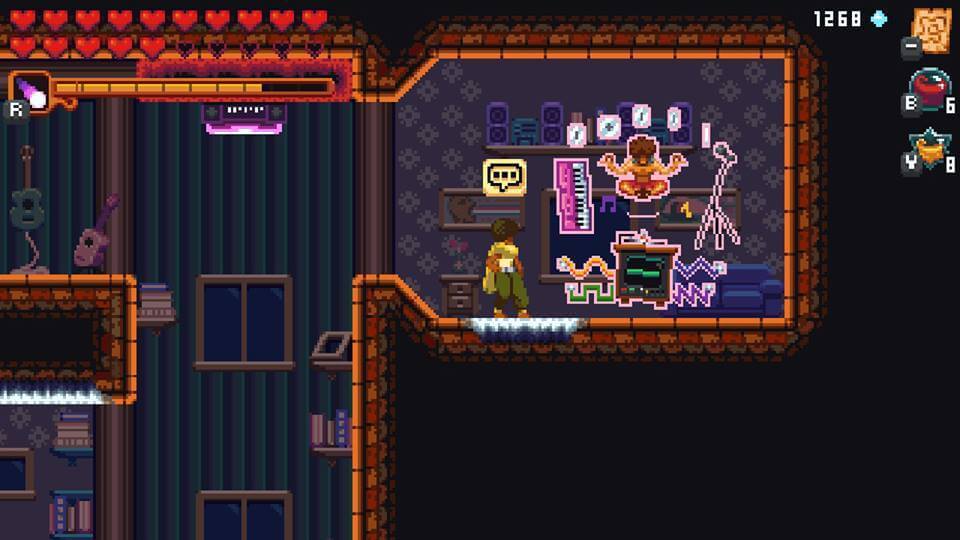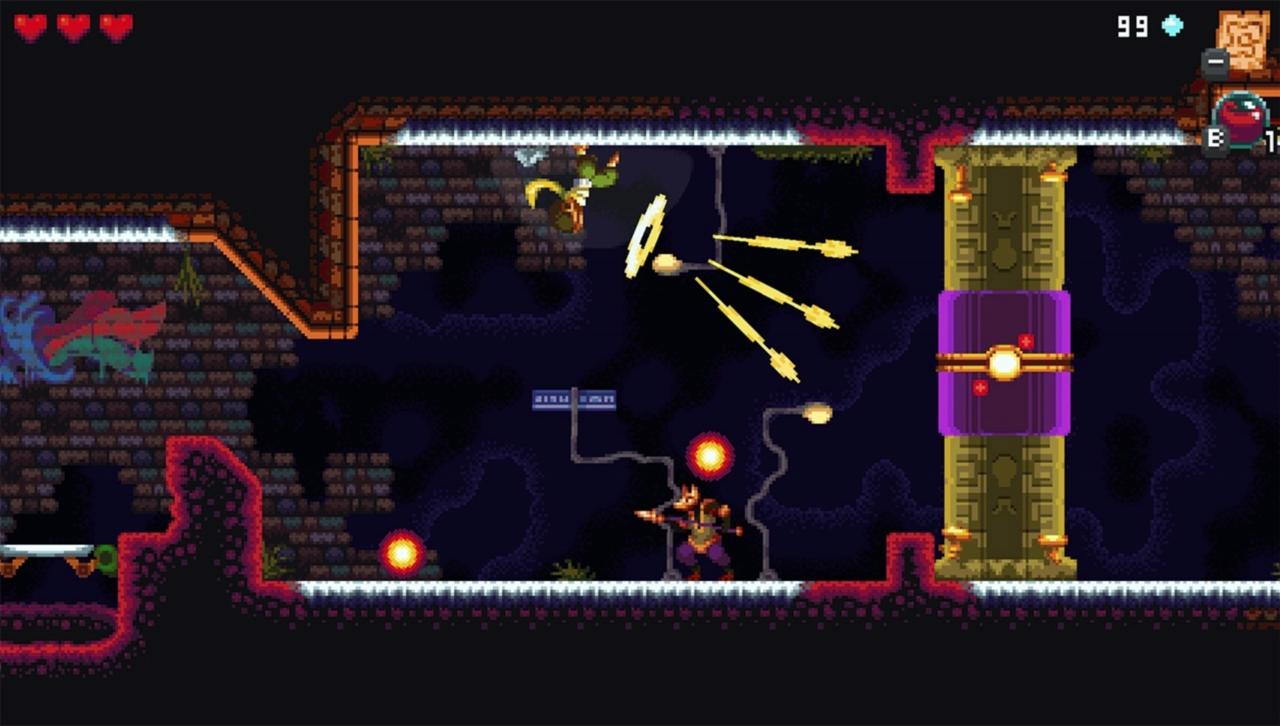Dandara defies its platforming heritage by subverting two ubiquitous ideas: jumping and running. Neither is present in the traditional sense within this surreal, Metroid-inspired adventure. Rather, the heroic Dandara slings herself to any wall, ceiling, or floor she fancies, thumbing her nose at gravitational forces that would dare stifle her kinetic charm. This spin on standard movement sets Dandara apart, making it feel different from every other exploration-heavy platformer. When you’re zipping carefree through its labyrinthine world, Dandara is a complete joy, but control hiccups and a story that’s too vague for its own good often undermine its unique charm.
Although Dandara is based on a Brazilian figure who helped lead a slave revolt in the late 1600s, you wouldn’t know it based only on the game’s surreal tale. The story is one of oppression told through vague metaphors about a broken world whose currency, salt, is in short supply. The sporadic conversations Dandara has with the trapped inhabitants does little to inject the world with any sense of humanity. The story is simply too abstract to create the lasting bonds that could have propelled Dandara forward with a real sense of purpose.
Thankfully, the imaginative action sequences grab hold of your attention in ways the story cannot. Dandara doesn’t walk. Instead, she leaps to designated spots that dot the walls, floors, and ceilings. Aiming the analog stick in a given direction shows where Dandara will land, and though her reach is limited, you can quickly bounce between surfaces to dance past enemies or arrive at a nearby treasure chest that’s waiting to be opened.
This simple action is the basis on which the entire adventure is built. Because Dandara’s leaps have limited range and you can only latch on to certain places, navigating each room becomes a small puzzle as you decipher how best to reach the next area. In some places, there are rotating blocks or gliding platforms that Dandara can control by firing a burst of energy from her palms, while other rooms have tracking lasers that demand a frantic pace lest you wind up dead. There’s a great variety in what each section demands, ensuring you don’t fall into a dull routine of simply looking for the white spots along the walls without any deeper thought.
Of course, Dandara can do more than just leap to any surface. She has a projectile weapon at the ready, one that’s slow-acting so you can’t just spam your foes. It takes a second or two to charge so you have to plan your assault–if you don’t, a wayward projectile could smack you while you’re gearing up for a strike. This smart system means that even though you always have the ability to fight, it’s often better to avoid confrontations rather than risk taking damage. Eventually, Dandara does acquire new projectiles that can be unleashed instantaneously, but these are limited by an energy bar. Because every attack has an obvious downside, mastery of movement is ultimately the key to staying alive.
However, mastering movement is no easy task. Even though I spent more than 10 hours exploring this world, I never felt completely in control. The line that sprouts from Dandara to show where you’re going to land can be fiddly. Too often I had to adjust and then readjust my aim because it would auto-aim to a specific spot that I didn’t want to be on. And though that wasn’t much of a problem, quickly bounding across a hazard-strewn section was way trickier than I would have liked. Precision felt like it came at the cost of speed, so I would get smacked around by enemies as I tried valiantly to make my way to a safe area.








There’s one section late in the game that should have been the exhilarating climax everything had been building toward. It has narrow walls and five different types of enemies preventing any chance of reprieve. I was all set to show off my jaw-dropping movement abilities and dispatch the enemy swarm with the style I had learned during my hours with the game. But the reality of the situation was that instead of evading the homing missiles barreling toward me, I would accidentally fly directly into them. The same clumsiness persisted as I tried to time my leaps to counter an enemy flipping between the floor and ceiling. Because I had so much health by this point, I was able to progress with little more than a bruised ego, but it was an ugly victory. That moment in platformers where you show off all that you learned is one of the reasons I love the genre. Moving so awkwardly even as I reached Dandara’s end was a bummer.
It’s a shame that the control can be a little tricky, because Dandara is an utter delight when things really click. There’s a boss fight early on where you chase an enemy through the nothingness of space. Platforms appear out of thin air as you hunt him, and you have to bounce across the broken landscape while dodging projectiles and spawning enemies to get close enough to land a counter attack. When I finally vanquished my opponent, I felt like taking a bow. The speed and precision required pushed me to my limits, and though I died a dozen or so times, it was a serious rush when everything coalesced into a beautiful dance. But Dandara doesn’t often reach those heights. Later scenarios require even more speed and precision than that early boss fight, and because there’s a slight auto aim on your jumping point, I often felt bit out of control as I zipped around.
If you play on the PC, you do have the option of using a mouse, but it’s a little cumbersome. Although it’s slightly easier to aim for a specific spot, it’s much slower, and areas where you have to quickly bounce from one place to the next, avoiding traps on the ground while dodging projectiles from angry enemies, are tougher without a controller. No matter which control method you choose, though, Dandara is forgiving enough that I never got angry. Frequent checkpoints mean you’re rarely more than 30 seconds from where you last died, and Dandara has plenty of health to help her withstand a few stray attacks.








The level design is another strong point. The world rotates as you turn ceilings and walls into floors, making you put a little thought into figuring out which way is up. But even as everything flips and twist around you, it’s still clear where you need to go next. There are only so many unexplored paths at a given time, so a quick peek at the map should be enough to get you moving to your goal. And as you explore, there are plenty of fascinating sights to behold. The most impressive comes late in the game in a nightmare world where swirling vortexes dot the foreground while mystical islands drift behind you. It’s a stunning area that made me pause to take it all in. The same mesmerizing feeling came from the enchanting music. Even though the story comes up short, the visuals and music really transport you to an imaginative world just begging to be discovered.
Careful explorers are rewarded with bonuses that help against the tougher boss fights. Dandara can use the salt she collects from defeated enemies and treasure chests to boost her abilities. Although you don’t need to upgrade often during the early going, as you earn more and more salt toward the end of the game, and the bosses get harder and harder, you really need the extra burst of health and energy these upgrades provide. But, more importantly, it’s just fun figuring out how to reach every hidden room and unlock every treasure chest. Even when a chest doesn’t yield a particularly valuable reward, simply solving a tricky puzzle to get the chest is satisfying on its own.
There have been so many Metroid-inspired games that it’s almost impossible to stand out. Dandara’s unique movement abilities ensure it’s at least significantly different from its peers. But the same reason that Dandara is so unique is also its biggest setback. The sense of mastery never quite comes, resulting in a game that flashes its potential in one scene only to undermine that thrill soon afterward. Even with its occasional stumbles, though, Dandara offers enough excitement and beauty to push you onward.
Website: LINK


